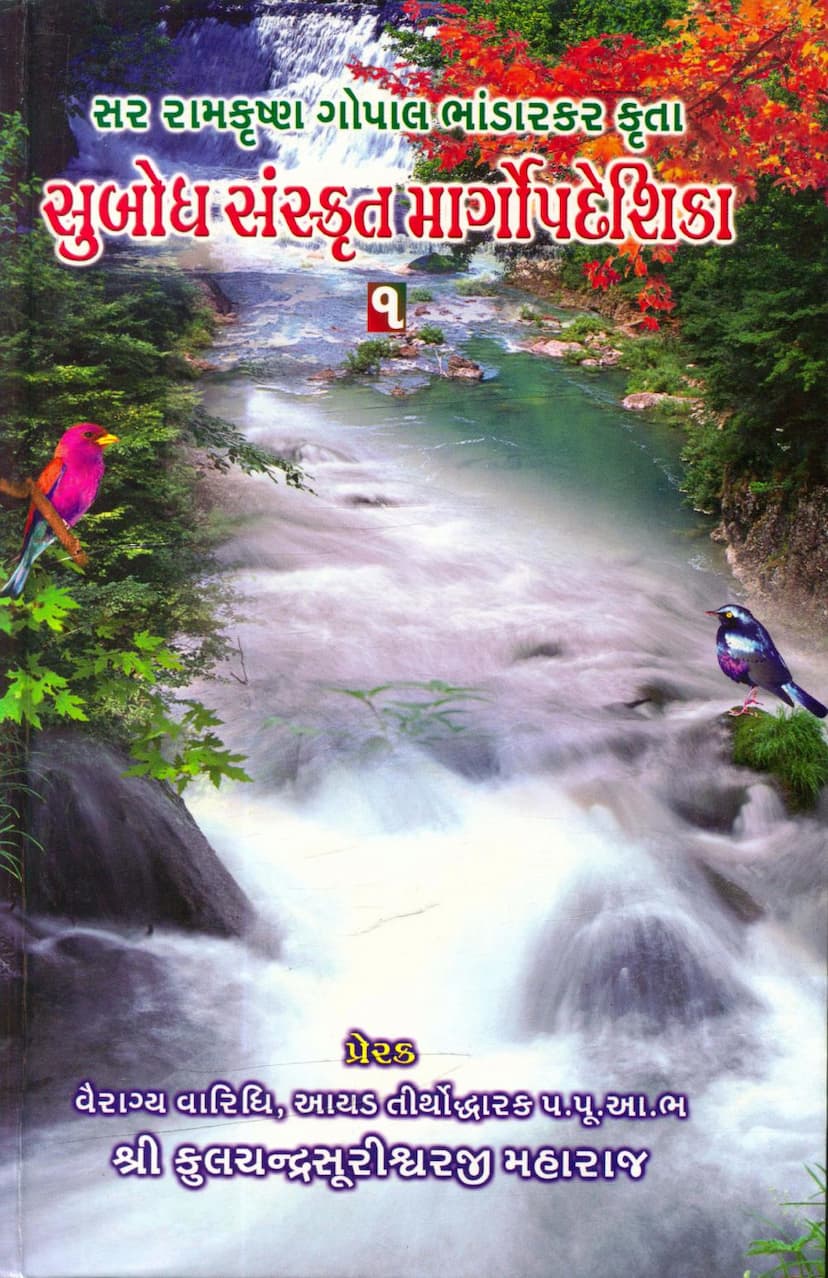Subodh Sanskrit Mandirant Praveshika Part 01
Added to library: September 2, 2025

Summary
This comprehensive summary details the content and structure of "Subodh Sanskrit Mandirant Praveshika Part 01" by Ramkrishna Gopal Bhandarkar, published by Divya Darshan Trust.
Overall Purpose: The book is designed as an introductory guide to Sanskrit, specifically for those aiming to study Jain scriptures. It aims to make the complex Sanskrit language accessible with a focus on ease of learning and practical application.
Key Features and Content:
- Author and Publisher: Written by Ramkrishna Gopal Bhandarkar and published by Divya Darshan Trust. The catalog link is provided as jainqq.org/explore/022986/1.
- Target Audience: Primarily intended for monks, nuns, and those involved in the study of Jain scriptures (Gyanbhandar). While Shravaks (lay followers) can own it by making a monetary contribution to the 'Gyan Dravy' (knowledge fund), the primary distribution is for religious scholarship.
- Structure and Content: The book systematically introduces Sanskrit grammar and vocabulary through a series of lessons (Path).
- Grammatical Foundations: It begins with fundamental aspects of Sanskrit, including:
- Alphabet and Phonetics: Classification of vowels and consonants (Path 14, 15).
- Sandhi Rules: Explanation of vowel, consonant, visarga, and anusvara sandhis (Path 5, 12, 13, 19, 20, 26).
- Nouns and Declensions: Detailed lessons on the formation of noun cases (vibhakti) for masculine, feminine, and neuter genders, covering various endings like akaranta, ukaranta, ikaranta, makaranta, nakaranta, sakaranta, and ṛkaranta (Path 5, 6, 7, 8, 9, 10, 11, 13, 14, 15, 16, 19, 20, 21, 25, 26, 27). It provides formulas for memorizing noun forms.
- Verbs and Conjugations: Extensive coverage of verb conjugations, focusing on the present tense (vartaman kal) in both parasmepada and atmanepada forms, across different persons (first, second, third) and numbers (singular, dual, plural) (Path 1, 2, 3, 4, 10, 11). It also introduces the imperfect tense (hyastan bhutkal) (Path 16, 17, 18) and the imperative mood (ajnyarth) for both parasmepada and atmanepada (Path 22, 23).
- Krit and Tadhit Affixes: Lessons on various verb-derived words (kṛdant) and noun-derived words (taddhit), explaining their formation and usage (Path 24).
- Upasargas (Prefixes): Introduction to the role and meaning of prefixes in modifying verb and noun meanings (Path 4).
- Vocabulary Building: The book includes Sanskrit-Gujarati and Gujarati-Sanskrit word lists to aid in language acquisition.
- Practical Exercises: Each lesson is followed by 'Swadhyaya' (study exercises) comprising Sanskrit-to-Gujarati translation and Gujarati-to-Sanskrit translation, reinforcing the learned concepts.
- Grammatical Foundations: It begins with fundamental aspects of Sanskrit, including:
- Pedagogical Approach:
- Gradual Progression: The lessons are structured to gradually introduce grammatical concepts.
- Clarity and Simplicity: The author and editors have focused on simplifying the rules and vocabulary for easier comprehension. The inclusion of specific explanations for dual and plural forms, and the methodical presentation of noun declensions are key elements.
- Emphasis on Swadhyaya: The inclusion of exercises at the end of each lesson highlights the importance of self-study and practice for mastering the language.
- Inspirational Tone: The preface and introductory remarks by spiritual leaders like Acharya Shri Prem Surishwarji Maharaj and Acharya Shri Fulchand Surishwarji Maharaj emphasize the spiritual significance of Sanskrit study, particularly for realizing the depth of Jain scriptures and achieving spiritual progress. They highlight Swadhyaya (self-study) as the highest penance.
- Specific Content Highlights:
- Path 1-4: Cover present tense verb conjugations (parasmepada).
- Path 5-10: Detail noun declensions for various endings and genders, including sandhi rules.
- Path 11-12: Cover atmanepada verb conjugations and passive/impersonal voice (karmaṇi and bhāve forms).
- Path 13-15: Focus on feminine noun declensions.
- Path 16-18: Introduce the imperfect tense (hyastan bhutkal).
- Path 19-20: Explain masculine and neuter nouns ending in -ṛ and -u, and masculine, neuter, and feminine nouns ending in -u and -ṛ.
- Path 21: Covers feminine nouns ending in -i and -u, and their case formations.
- Path 22-23: Introduce the imperative mood (ājñārth).
- Path 24: Focuses on useful kṛdant forms (verb derivatives).
- Path 25-26: Detail nouns ending in consonants ( vyañjanānt).
- Path 27-31: Cover various noun endings and pronoun declensions.
- Dedication and Inspiration: The book is dedicated to Acharya Shri Prem Surishwarji Maharaj and Acharya Shri Fulchand Surishwarji Maharaj, acknowledging their profound influence and scholarly contributions. The introductory pages also express gratitude to Muni Shri Ratnarajvijayji and Muni Shri Chirantanratna-Vijayji for their work in revising and compiling the text.
In essence, "Subodh Sanskrit Mandirant Praveshika Part 01" is a foundational textbook for learning Sanskrit with a Jain focus, meticulously structured to guide students from basic phonetics and grammar to the application of these principles through practical exercises, all within a spiritually enriching context.